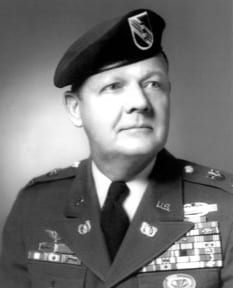Leo J. Meyer
Description
After serving in the Pacific Theater of Operations, Master Sergeant Leo J. Meyer was commissioned a Second Lieutenant in the U.S. Army Air Forces 3 March 1943. His USAAF Officer Candidate School class 43-B was located in Miami Beach, Florida. His first of many duty assignments was as Director of Training, 26th College Training Detachment (Air Crew), Mt. Union College, Alliance, Ohio.
Leo Meyer’s Army career began in October 1937 when he enlisted into Company B, 102nd Engineer Regiment. By May 1940 he had been promoted to corporal and was called in October, along with his National Guard unit, the 27th Division, to active Federal Service for twelve months training at Fort McClellan, which was extended for an additional six months. Because of “old timer” attrition and his determination to be the best Soldier he could be, he moved up the enlisted ladder quickly. Just three weeks before 7 December 1941 at age 24 he reenlisted as a Regular Army master sergeant and assumed duties as Regimental Sergeant Major. His division, first major command on continental United States to deploy, left for California on 14 December 1941 and then on to the west. From January 1942 to December 1942 he served, after reorganization, as the Battalion Sergeant Major of the 102d Engineers. In March 1943 he graduated from the U.S. Army Air Forces Officer Candidate School. In 1944 he volunteered for service in the infantry, and in June 1945, after months of training combat replacements at an infantry replacement training center, he was serving as a First lieutenant in Company ‘A’, 34th U.S. Infantry, 24th Infantry Division in the Philippines. He earned his first Combat Infantryman Badge, two Bronze Star Medals and a Purple Heart Medal during Operation VICTOR V in the Southern Philippines Campaign.
After serving in occupied Japan as a captain he returned home and mustered out of the Army and reenlisted in the Army Organized Reserve Corps. By June 1947 he was back on active duty as a Regular Army master sergeant instructing reservists while earning his GED in New York City. He re-entered active commissioned service as a FirstLieutenant in 1948 and served in the 7th U.S. Infantry, 3rd Infantry Division at Fort Devens. By November 1950 he was in North Korea serving in 3rd Battalion, 7th U.S. Infantry, which served as the nucleus of "Task Force Dog", the forward element of the covering force for the Army’s 31st U.S. Infantry Regiment and the 1st Marine Division withdrawal from the Chosin Reservoir. He earned his second Combat Infantryman Badge during the Chinese Communist Forces Intervention Campaign, a second Purple Heart Medal, a third Bronze Star Medal and a Soldier's Medal for saving a fellow officer from drowning.
After rotating back to the United States, Captain Meyer served in a variety of assignments beginning with advisor to the Massachusetts National Guard, followed by USAREUR staff officer in Bad Kreuznach, Germany, an operations security officer at the Army Disciplinary Barracks in New Cumberland, Pennsylvania, and as a headquarters operations staff officer at Fort Dix, New Jersey. In 1961 he was a reserve infantry major on the active duty list and, in lieu of mandatory retirement, he reverted to Regular Army warrant officer 3; having applied for and approved for Regular Army Warrant program in 1947. Because of ‘time in grade’ on the warrant officer list, he was a chief warrant officer (CWO) 3. After changing his MOS to Intelligence and attending school at Fort Holabird, Maryland, he was promoted to chief warrant officer 4 as a Counterintelligence Technician in the Counter Intelligence Corps. He served in New York City, New York, Camden, New Jersey, Honolulu, Hawaii and Washington, D.C. In 1967, he received his Bachelor of Science Degree in Military Science from the University of Maryland and the following year he volunteered again for service in a combat zone.
At age 51 he was assigned to 5th Special Forces Group (A), 1st Special Forces, in Nha Trang, Vietnam. Chief Meyer earned his 3rd Combat Infantryman Badge, a Navy Commendation Medal with ‘V’ device while serving in the Navy controlled Rung Sat Special Zone with his Special Forces unit, 5th Mobile Strike Force, B55 in his second month in Vietnam and in May 1969 he earned his Jump Wings through the South Vietnamese Special Forces Parachute School. In March 1969 he had been promoted to Colonel in the Army Reserve but continued serving as a military intelligence Regular Army CWO4 on active duty.
From 1969 to 1971, Chief Meyer was again assigned in the Washington, D.C. area as an Counterintelligence Technician with the 109th and 116th Military Intelligence Groups. In his last billet, he was the acting Executive Officer of the 116th MI Group, normally a lieutenant colonel position.
During thirty-three enlisted, warranted and commissioned years in an Army uniform, Leo Meyer served in a variety of positions from headquarters staff to small unit commander. In three conflicts, his commissioned and warrant officer combat service earned him the Combat Infantryman Badge (CIB); being one of a very few in the 20th Century Army to receive three awards of the Combat Infantryman Badge. In 1971, at the end of thirty years of Federal Service, he retired as a colonel, Army of the United States.
Colonel Meyer was buried at Arlington National Cemetery on 18 May 2006.

